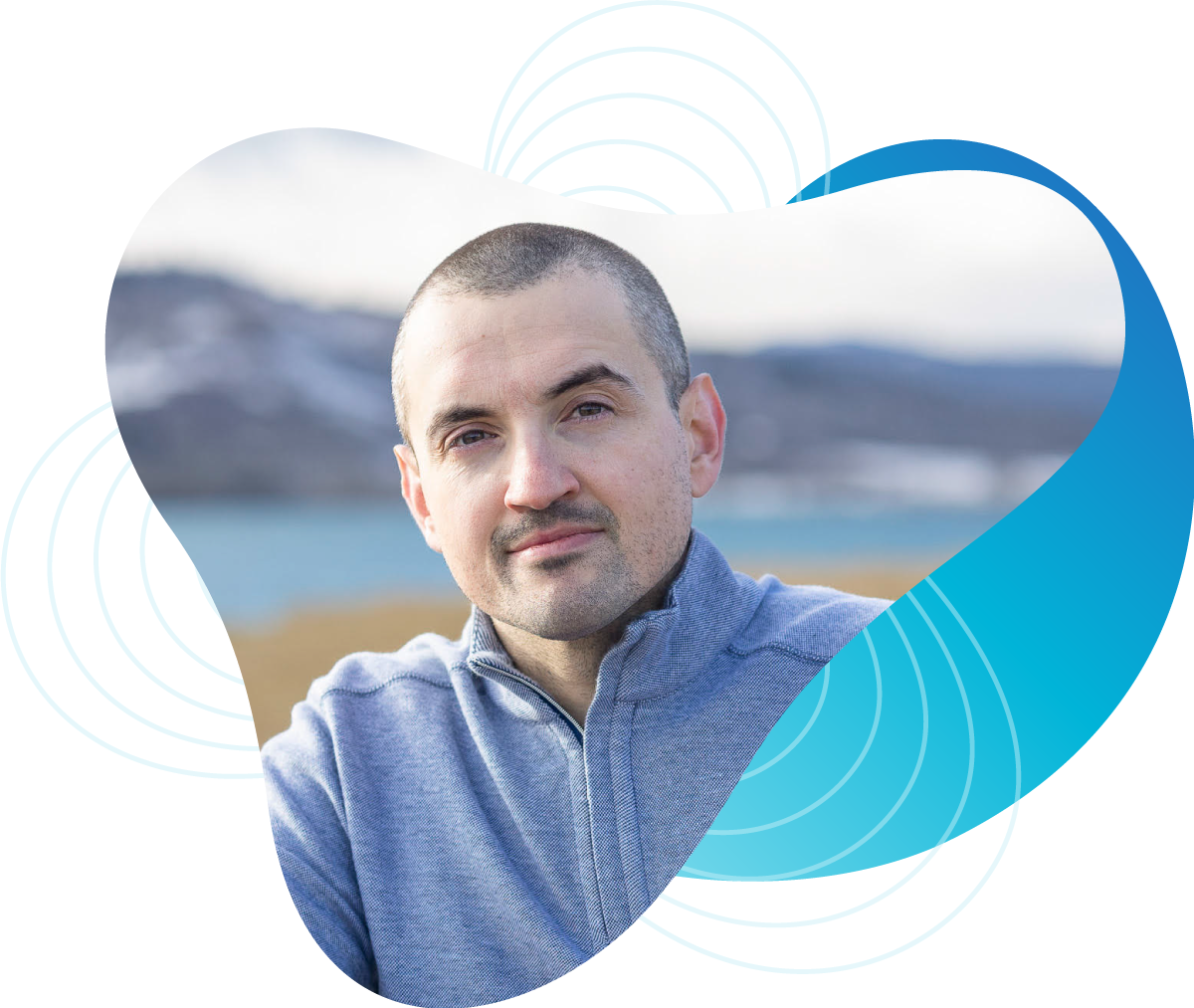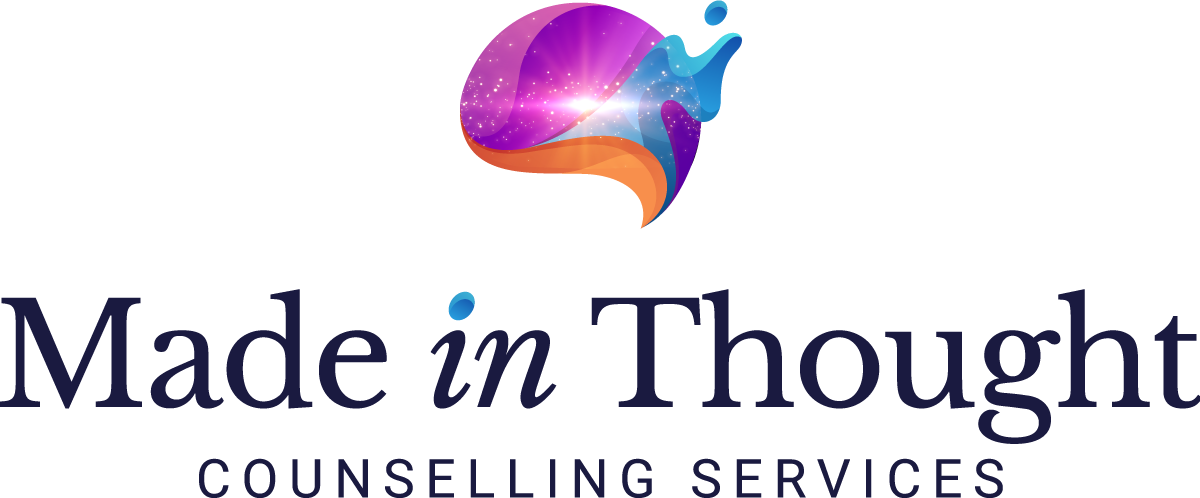The Art of Anxiety

Tudor Caliman, Registered Psychologist
Founder, Made in Thought Counselling Services

What you resist persists.
– Carl Jung
Believe it or Not
In the rhythmic dance of life, anxiety moves. Remarkably, anxiety can possess an artistry despite, or in spite of its frightening nature. It triggers us in real-time, affecting our bodies and intertwining with our senses, thoughts, and interpretations. Our temperaments, experiences, beliefs, and subjective meanings constantly shape anxiety, making it a complex and dynamic phenomenon.
Anxiety is a personal and interactive movement, intimately linked to our perception of internal bodily sensations, our interactions with ourselves, others, and the environment. It’s a relational experience, entangled with our sense of self and the intricate architecture of our brains. The way we think reinforces our patterns of thinking, shaping the unfolding of our thoughts and interpretations. A back-an-forth dynamic emerges, where the shaper becomes the shaped, perpetuating its own self-reinforcing forecasts. In essence, how we define and perceive ourselves defines and reveals our experience of anxiety, and vice versa.
Anxiety can be viewed from various perspectives, including its entanglement with our biological predispositions and biochemical compositions. Moreover, it can be seen as a learned skill, honed over time and subject to individual interpretations. Just like any diligently practiced skill, anxiety becomes finely tuned and efficient. Regrettably, as we become more proficient in the art of anxiety, we unintentionally amplify our unease and fright. Neural pathways wire themselves to respond in specific ways, increasing the frequency, duration, and intensity of anxiety, resulting in a personalized tapestry of anxiety.
Anxiety arises when we lose touch with the present moment, preoccupied with expectations, and distracted from the actuality of life. The wider the gap between our wandering thoughts and the here-and-now, the more we fan the flames of anxiety. By bridging this gap, we can uncover, rather than discover, peace – not by relentlessly pursuing happiness, but through a deep insight that we have the capacity to be okay amidst uncertainty.
Every moment beyond the present is unknown and uncertain, filled with possibilities and probabilities.
The drive to create a sense of preparedness and security activates the urge to problem-solve for these unknowable events. It’s often assumed that once we “fix” anxiety, we can live in peace and happiness. Strangely, this view may trigger further anxiety. Instead, we can embrace multiple experiences, acknowledging our anxious states of mind while recognizing our resilience and strength.
Conditional love is fragmented love. To sense our wholeness, it’s important to love ourselves fully rather than dividing ourselves into pieces or fragments. Just as an elephant is more than its trunk, tail, or tusks, we are more than the sum of our parts and imposed labels. Demystifying anxiety is crucial in deflating its impact and understanding its interconnected nature. By integrating all aspects of ourselves and acknowledging the diverse elements that contour our identities, we can activate a holistic and balanced state of being, where multiple experiences can coexist.
Imagine
Imagine that you’re feeling hungry, and your thoughts turn to the food you’re craving. As you dwell on the details of how it tastes, smells, looks, or sounds, and consider where to get it or how to prepare it, your body responds to these wandering thoughts. You may notice your mouth salivating, your heartbeat quickening, or perhaps some fidgeting. Now, replace this anticipated image with your worst nightmare… This illustrates how our thoughts and emotions influence our experiences, and in turn, how our experiences shape our thoughts and emotions.
Imagination is a remarkable tool that gives rise to art, architecture, technological advancements, and much more.
However, from a psychological standpoint, it can also lead us astray into deception and illusion. We have the capacity to imagine certain states of mind, like happiness or worry, and can become fixated on pursuing or avoiding these different states. Unfortunately, this may cause us to lose touch with the moment at hand. The images fueled by our longing for safety and security can reinforce repetitive patterns of experience, which we mistakenly identify as our life. Instead of recognizing them for what they are, we become trapped in these self-perpetuating cycles. Anxiety seeks out and thrives in the fertile landscapes of our thoughts, where our attention is intensely focused, and our states of mind are activated.
Let’s now delve into the vivid nature of anxiety – a potential paradoxical and ironic phenomenon intricately woven into our lives. Anxiety is more than a fleeting moment; it’s the essence of that moment. When anxiety engulfs us, we become entangled in the ripples of our bodily sensations, thoughts, knowledge, and experiences. Our creative thoughts and steadfast beliefs can transform tranquility into restlessness and worry. Whether immersed in a peaceful or distressing “guided” mental image, both types captivate us through focused attention, immersion, time, and energy. Our subjective reality aligns with our mindsets and physiological reactions, and vice versa. Vivid and imaginative thoughts, fueled by our temperament and experiences, package the experience we label as anxiety. Mental images span a spectrum from tranquil to distressing, leaving an impact on our subjective reality. It’s important to be aware of the delicate boundary between the necessary use of thought, such as in learning and performing brain surgery, and the illusory psychological images that can lead to anxiety, like ego-driven desires to be the best.
Master of Disguise
Anxiety, with its ever-shifting contours, is a master of disguise. It can assume diverse forms, often masquerading as fear, while its true nature lies in its ability to divert our attention towards the shadows and uncertainties of life. Like a skilled illusionist, it leads our gaze away from the present moment, luring us into a labyrinth of what-ifs and possible worst-case scenarios.
Fear and anxiety, though often used interchangeably, have distinct yet interconnected natures. Fear is an immediate response to an actual event – a sudden startle followed by a racing heartbeat. It serves as our instinctual survival mechanism, reacting to present and tangible threats. Fear emerges as a biological and physiological reaction to distressing or menacing situations, triggering our fight, flight, freeze, or faint response.
Anxiety, on the other hand, with its many expressions, is rooted in our psychological response to underlying fears. It perpetually refines our reactive states of fear by constructing various scenarios and narratives. Anxiety unfolds as the story of our fears, preoccupying our minds with alarming thoughts through mental imagery. Ironically, the onset of fear momentarily interrupts the movement of anxiety, by briefly bypassing the analytical, image-constructing, future-oriented states of mind and propelling us straight into action needed in the present moment.
Despite feeling trapped in the experience of anxiety, it’s important to recognize that anxiety is a movement. It moves us, making it difficult to find peace when anxiety speaks. Our interpretations hold immense power – they have the capacity to both comfort and torment us, conjuring awe, beauty, and nightmares alike. In this paradoxical dance, thoughts become a double-edge sward, blurring the line between solace and unease.
A Double-Edged Sword
Anxiety yearns for an answer, an antidote to quell its unsettling presence
Knowledge appears to hold the key. Paradoxically, however, knowledge rooted in memory and the past carries within it the seeds of anxiety. It unveils the intricacies of our existence, shedding light on our actual vulnerabilities and assumed uncertainties. The pursuit of knowledge, while encouraging enlightenment and potential resolutions, may also incite the movements of anxiety. This leaves us grappling with the paradox of seeking solace in the very source that can also activate our fright.
In our quest for knowledge to fill the void of uncertainty, we often rely on information from the past to anticipate future threats. It’s vital to recognize the boundaries and limitations that narrow our understanding. Our consciousness is bound by the knowledge we have accumulated, both directly or indirectly, and we don’t know what we don’t know. Knowledge is limited by what we know at any given moment, and its effectiveness depends on our ability to access and apply it to the best of our abilities. It’s difficult to know something that is not yet known and may remain unknown until the moment of discovery or revelation arrives. Despite this, we often blame ourselves for not knowing what was unreasonable to know at the time, stirring up various thoughts and emotions.
Knowledge is inherently limited and fragmented, acquired and revised throughout the course of our lives. As knowledge can never be all-encompassing, any action undertaken from this place is inherently limited and incomplete. The very drive for ‘the pursuit of knowledge’ stems from this recognition, despite our inclination to favor the ‘certainty’ of things to quench the thirst for security.
Patterns emerge within the cultured web of our brains as neural connections wire and rewire, influenced by our temperaments, relationships, and experiences. Our brains, skilled at prediction, anticipate future events based on past experiences. This tendency can inadvertently lead us astray, triggering self-sabotage, confirmation bias, and self-fulfilling prophecies.
Self-sabotage refers to knowingly or unknowingly taking actions that may hinder our own progress or well-being. It’s an act of sabotaging our own success, often driven by underlying fears, insecurities, or self-doubt. These self-defeating behaviours bring forth the storms we seek to avoid, perpetuating their existence.
Confirmation bias, another cognitive phenomenon, influences the way we perceive and interpret information. It describes our inclination to seek out and give more weight to evidence that confirms our existing beliefs, while disregarding contradictory information. These bias shapes our perception of ourselves, others, and the world, reinforcing our preconceived notions and potentially distorting our understanding.
Furthermore, self-fulfilling prophecies play a role in shaping our experiences. When we hold certain beliefs or expectations about a future outcome, our behaviour tends to align with those beliefs, increasing the likelihood of the predicted outcome becoming a reality. Our actions, driven by these beliefs, unwittingly contribute to the fulfillment of our own expectations.
Anxiety, intricately intertwined with our biology and development, becomes an interactive experience, molding our perceived relationships with ourselves, others, and the world. As we navigate this knotty dance, it’s vital to retain that anxiety is not an external force imposed upon us; it’s a movement indivisible from our sense of self.
Beliefs and Pursuits
Anxiety mirrors the ebb and flow of our mindsets, driven by an innate logging for wholeness. Paradoxically, when we try to stifle anxious thoughts, they may persist with greater intensity. It’s like trying to banish thoughts of a polar bear, which only fills our mind with its relentless presence. These anxious states often lead us to believe that something within us is broken and needs fixing, whispering doubts about our worth and casting shadows on our sense of self. It’s a disconnecting thought process that produces broken narratives, expecting wholeness from a place of fragmentation.
For instance, thoughts laden with “should” rarely bring forth happiness, peace, and fulfillment. Instead, they imply a sense of inadequacy and bear a punitive nature. In our perpetual quest for answers, we become fixated on finding “solutions,” losing sight of the journey itself and solely focusing on reaching a destination. Can we truly recall a time when a “should” thought brought us genuine contentment? And yet, we find ourselves perplexed by the lingering sense of dissatisfaction.
Ironically, the experience of anxiety can breed further anxiety as we desperately seek ways to quell its restlessness (remember the polar bear?). Using anxiety as a weapon to combat anxiety can become a self-defeating endeavor. It’s challenging to unlearn and change something that we consistently attend to, listen to, and unintentionally nurture – a skill we frequently utilize and refine. So, what motivates and fuels our desire to ‘get rid’ of anxiety? And in this urge and pursuit, do our expectations inadvertently drive our symptoms of anxiety?
We are not Possessed
Anxiety doesn’t possess us; we possess it.
Or, more accurately, there is no possessing, only shifts in our nature as we respond to internal and external movements. In moments of distress, we and anxiety are one. Drawing a dividing line between ourselves and anxiety may fuel its momentum. The movement that is anxiety thrives on beliefs of disconnection, division, inadequacy, and a lack of safety and security. Engaging in this relentless tug-of-war reinforces our sense of incompleteness and disconnection. It becomes challenging to experience a sense of wholeness when our focus is constantly directed towards dividing, separating, disconnecting from, getting rid of, eliminating, or shelving anxiety (a.k.a. ourselves). Instead, we can shift our mindset from one of control and suppression to that of understanding, compassion, and acknowledgment.
Anxiety encompasses both anticipation and a reaction to its own anticipated conception. It weaves intricate images, narratives, and reactions around our fears – creating a continuous cycle that revolves around potential or anticipated threats to our connection, wholeness, support, safety, and overall well-being. The instinctive urge to avoid these anticipated threats can serve as a driving force behind the emergence and persistence of anxiety – setting an ongoing self-sabotaging cycle in motion. The very inability to anticipate the actuality of what’s to come drives our knack for anticipation, turning it into a bottomless pit of food for thought.
We find ourselves caught in a struggle, anxious about being anxious, and using anxiety to find a “cure” for itself. It’s like grappling with a mirage, believing that we are quenching our thirst with water when, in actuality, we are ingesting sand. How can we awaken when we genuinely believe we are already awake? After all, how can we not be awake when the experience of our struggle unravels in the here-and-now?
The tapestry of anxiety weaves together potential paradoxes, offering glimpses into the intricate nature of the human experience, where irony and contradiction hold sway. Within this paradoxical realm lies an invitation to explore and uncover solace within anxiety’s enigmatic embrace. By embracing anxiety, we embrace ourselves at the very moment we need embrace, support, comfort, and validation. Through this candidness, we can rekindle compassion amid life’s storms, unearthing forgotten insights buried by the debris of fragmented thoughts. While we often seek unconditional love externally, do we grant ourselves permission to bestow that very love upon ourselves?
Concluding with Imagery
The origin of anxiety unfolds like paintings filled with apprehension, with each canvas capturing countless stories teeming with potential meaning.
Within the perceived frames of the past, present, and future, we encounter a vivid collage of “what ifs,” “could haves,” “should haves,” and “would haves.” Like skilled artists, our thoughts paint intricate scenes of potentially unpleasant possibilities.
Whispering thoughts reverberate within the chambers of psychological time, echoing like captive hums trapped in a seashell. Instead of hearing the ocean, we hear our fears defined by our experiences and thoughts of anticipation. Time, to us, is not merely the ticking of a clock or the turning of a calendar page; it’s also a subjective, psychological experience shaped by our encounters and personal journey, fostering a fluid and deeply intimate perception of its passage. Within this delicate shell of constant contemplation, worries refine their form, weaving together a tapestry of doubts and concerns. They beckon and assail us, akin to the seductive sirens of Greek mythology, luring us to listen and heed their enchanting call, unaware of the treacherous path that lies before us. As we descend deeper into the abyss of apprehension and unease, we are the seashell itself, one with the hums of our anxious states of mind.
Anxiety, much like paintings, seashells, or sirens song, evokes a symphony of emotions, memories, and thoughts within us, capturing fleeting moments that may never be recaptured or unfold. It toys with time, entangling us in a ceaseless loop of anticipation and self-doubt. Its grip distorts reality, blurring the boundaries between imagination and actuality. Yet, we must remember that when anxiety speaks, it speaks with our tone. Though we may refer to anxiety as an “it,” we are inseparable from it. We are the amalgamation of thoughts and emotions, wholly immersed in the experience of anxiety. We are not mere vessels being possessed; we are active participants, where the experience of anxiety cannot be severed from the experiencer – ourselves.
Anxiety’s grip can be unwavering, compelling us to follow its tune while skillfully concealing its true nature. Whether knowingly or unknowingly, our insecurities and distress shape our perceptions, holding the potential to ignite self-sabotage and inadvertently fulfill our own prophecies. Thus, we find ourselves trapped in a relentless cycle of worry and self-imposed limitations. We exist as both the experiencer of anxiety and the canvas upon which we intricately paint its patterns of experience. Thus, the paintbrush can truly be mightier than the sword – the art of anxiety.



